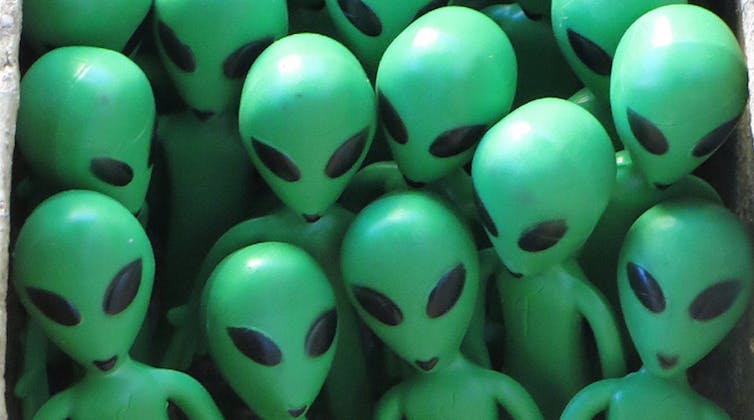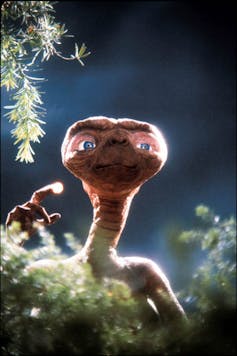
When looking for "extraterrestrial" on the search engine Google images, dozens of illustrations are proposed. The human imagination has not been stingy throughout the last century to give a thousand shapes to these mysterious invaders from another world. Sometimes large, sometimes tiny, sometimes with three eyes, sometimes one, these visitors, whether peaceful or aggressive, are very different from each other. Their description could fill an entire book of "exozoology," as once were the reasoned collections of the different varieties of the living that naturalist amateurs could meet. As diverse as these figures are, one point is striking in its constancy: most of our "space brothers" are bald. Whether ET, the little gray or the Annunaki, as the experts sometimes call them, these visitors do not have a hair on their skulls. Is this really a coincidence?
Most stories about extraterrestrial life describe civilizations above ours (which explains why they have the technological means to visit us). What may well be at work here is a certain representation of the theory of evolution. Indeed, the implicit hypothesis that supports the physical description of these beings is that, far ahead of us, they would represent, in a way, our future biological development. Often endowed with skull disproportionate to their bodies, these extraordinary beings obscurely constitute the ultimate stage of our future.

Thus the hair, this cousin of the body hair, is undoubtedly seen as an ersatz animal that does not suit a higher consciousness. In addition, the hair and body hair, which may have been useful in times when men were suffering from the rigors of temperature, would be doomed, the function creating the organ, to disappear slowly to reveal the power of a cortex whose fate would be to become ever larger. This vision of biological evolution - should we be surprised? - does not respect much of the orthodoxy of Darwinian theory. Indeed, it has rather frankly Lamarckian accents. Jean-Baptiste de Monet, Knight of Lamarck, considered with Darwin that the species were not immutable, but his theory, unlike that of Darwin, admitted that beings evolved according to the laws of a mysterious vital force, contained in all life, which guided biological evolution. The emblematic example of this theory is the idea that giraffes have long necks because the life force has lengthened them, their food being on the treetops. This acquired adaptation then became innate. The natural environment would have an influence here, which can not be explained otherwise than by the intervention of a metaphysical hypothesis: the vital force, on the biological structuring of beings. This acquired adaptation then became innate. The natural environment would have an influence here, which can not be explained otherwise than by the intervention of a metaphysical hypothesis: the vital force, on the biological structuring of beings. This acquired adaptation then became innate. The natural environment would have an influence here, which can not be explained otherwise than by the intervention of a metaphysical hypothesis: the vital force, on the biological structuring of beings.
Darwin, on the other hand, conceived of the evolution of species as the consequence of a natural process of selection which allows the survival of the best adapted individuals. In other words, individuals do not adapt biologically to their environment: if they survive, it is because they are, by chance, genetic combinations, better adapted than others. In this theory, giraffes did not suddenly see their necks growing, but chance has made some have longer necks than others. They had more facilities to feed themselves, and therefore to reproduce. Gradually, or suddenly depending on the case, the most adapted species saw its genotype spread, while the other saw it go out.
If we return to our extraterrestrials, this representation of higher beings statistically devoid of hair appears to betray the Lamarckian imagination of those who conceived them. To put it bluntly, it would be a remarkable miracle if all these brothers of space had evolved in the same way towards baldness. Of course, extraordinary coincidences sometimes occur. But in this particular case, perhaps it would be wiser, and in any case more parsimonious intellectually, to take seriously the idea that these descriptions are mere human inventions that would betray the bad conception that we usually have of the theory of evolution.
About Today's Contributor:
Gérald Bronner, Professor of Cognitive Sociology, Paris Diderot University - USPC |
| "Cabinet of Social Curiosities" - Front Cover |
Gérald Bronner is the author of "Cabinet of Social Curiosities", from which this text is an excerpt. The book was published by PUF / Humensis in September 2018.
This article is republished from The Conversation under a Creative Commons license.
(Translated from French to English for LoupDargent.info by Loup Dargent.)

















